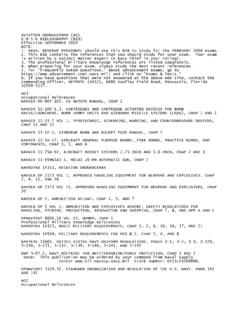Transcription of Rocket airframe concepts Rick Newlands - Aspire Space
1 Technical papers Author: rick Newlands 1 updated: 16/12/16 Rocket airframe concepts rick Newlands Introduction model /HPR/amateur Rocket vehicles tend to be thin-walled composite tubes. However, this choice is coloured by tube availability or ease of manufacture. If we look at the aerospace industry for inspiration, we see a variety of fuselage construction methods which are designed to get the weight off whilst remaining strong enough. The fuselage The fuselage is the body of the vehicle. It transmits the thrust force from the engine, and withstands the gee loads (the inertia loads caused by the internal payload masses being accelerated) without being crushed. It also withstands the aerodynamic lift and drag loads from the nosecone and fins (and any boat-tail/tail-cone). Tension When the chute opens, the fuselage will end up (eventually) with a tension load along it.
2 Even the thinnest body tube should be able to resist tension within it. Bending and shear In response to sidewinds with embedded gusts, the fins and nosecone create lift forces which bend the fuselage across its length. See our paper Rocket vehicle loads and airframe design on the Aspirespace website for details of shear forces and bending moments. This diagram imagines one central payload mass roghly in the middle of the body tube. As the vehicle accelerates to the left in respone to a gust, the inertia of mass M resists this acceleration and causes bending. Although circular in cross section, the body tube is a simple beam, so the bending causes tension on one side of the beam and compression on the other: As well as the bending, the loading caused by mass M causes shear, which is a force wanting to shear the body tube across its middle: Technical papers Author: rick Newlands 2 updated: 16/12/16 The shear force runs from one end of the tube to the other (nose to fins), changing sign at the point of application (fuselage position) of mass M.
3 Buckling Under thrust, and when the chute riser tries to zipper it, the fuselage is in compression (a crush load) and like a coke can that is stood on, will buckle: a sort of geometric crumpling failure. Buckling occurs at a far lesser load than would cause the fuselage wall to actually fracture under compression, so aerospace fuselage design is dominated by buckling failure. One way to stabilise a tube against buckling is to internally pressurise it like a balloon. This method was used on the original Atlas and Blue Streak missiles. Monocoque Standard HPR nosecones and circular body tubes withstand buckling fairly well, but that is because they have a frankly excessive wall thickness which adds much unnecessary mass. Monocoque is a French word meaning single shell. It describes this type of construction, where a stressed skin supports all of the loads (bending plus shear) much like an empty coke can: you can put a lot of your weight on a can before it eventually buckles.
4 Buckling resistance weakens with increasing tube length, so our monocoque tubes can withstand buckling much better (so we can use a thinner wall) if we divide their length into many short sections divided by hoops or bulkheads bonded firmly to the skin. These hoops don t add any strength to the tube, simply stabilise it against buckling, and need only be a few millimetres in width from their outer radius to their inner radius. You can then add to this construction using lengthways fore-and-aft beams known as stringers . (If only two or three stringers are used, they are then known as longerons ). The stringers withstand the majority of the compression load, and the tension/compression load of buckling, so the skin need only take the shear load. Again, they must be bonded firmly to the skin, and to the hoops and bulkheads.
5 When (multiple) stringers run the length of the fuselage it is called semi-monocoque construction , and allows a paper-thin wall. (In contrast, the use of just a few longerons needs a noticeably thicker wall which is stiff enough to retain its geometrical shape under bending forces.) A semi-monocoque fuselage weighs less than a pure monocoque despite the hoops and stringers. Shown below are the hoops and stringers of the Space Shuttle External Tank: Technical papers Author: rick Newlands 3 updated: 16/12/16 For Rocket fuselages, I would advise stopping short of a fabric skin for a semi-monocoque construction. At the high subsonic or supersonic airspeeds of our vehicles, such a skin would buzz in and out like a flapping sail, and probably tear. Several launch vehicles rout-out solid thick metal tube into multiple (many dozens of) small hoops and stringers, and the skin in between.
6 This is heading towards a sandwich construction (see below), and could be 3D printed nowadays. Isogrid The isogrid is a variation on this process, using triangular members. Nowadays, it is 3D printed rather than CNC routed-out. Technical papers Author: rick Newlands 4 updated: 16/12/16 Sandwich construction A composite sandwich contains a low-density, rather weak, core material onto which is bonded inner and outer stiffened sheet skins. The core stabilises the sandwich against buckling, deals with shear, and greatly increases the stiffness of the sandwich: sandwich construction is astonishingly lightweight for its stiffness; the thicker the core, the stronger and stiffer the construction. The core is often plastic rigid foam or honeycomb paper or aluminium construction. The outer skins are metal or composite.
7 Burt Rutan pioneered homemade composite sandwich construction for light aircraft (and now spacecraft) though wooden sandwich construction was used on the all-wooden British Mosquito WW2 fighter. Modern passenger jets now use carbon-fibre-faced sandwich fuselages. John Coker describes his use of honeycomb sandwich core material to produce extremely strong but lightweight HPR Rocket body tubes: Though one can manufacture a sandwich fuselage simply by pouring/spraying foam between two concentric tubes. Sandwiches work by smearing out loadings over considerable lengths of core so they don t handle point-loads like bolt or eyebolt loads well. To transfer a point-load into a sandwich, the load must be spread over a larger area using a bonded bulkhead, or a bonded-in wooden or plastic insert or ferrule.
8 The picture below shows ferrules bonded into dark-coloured solid epoxy inserts within the core: Technical papers Author: rick Newlands 5 updated: 16/12/16 The nosecone/boat-tail Cones are particularly resistant to buckling, and can use all of the above construction methods. Simply filling a cone full of foam produces a stiff member, though filling the gap between an inner and an outer cone produces a lighter conical sandwich. The fins The fins can be manufactured in similar ways. Again, moving on from simple flat stiffened composite sheet, can greatly reduce weight and increase stiffness. Note that a proper thicker aerofoil produces more lift and less profile drag than a flat sheet at all airspeeds. More lift allows use of a smaller fin, reducing skin friction drag. Fins are a form of wing.
9 Their internal structure transfers the aerodynamic loading on the fin skin into the fuselage via the fin root. The main elements of a wing are spars which are members anchored to the fuselage. The spars handle the shear and bending. A stiffened skin and ribs handle torsional (twisting) loadings, and preserve the aerofoil shape. Ribs and spars can be 3D printed, or alternatively the fins can be a sandwich with one or more spars. Unlike model aircraft construction, spars should use the full thickness of the fin for maximum spar depth as this allows the use of a lighter spar. Technical papers Author: rick Newlands 6 updated: 16/12/16 References 1. Aircraft structures for engineering students 3rd edition , Megson, Elsevier publishing 2. Stress without tears , Tom Rhodes 3. Moldless composite sandwich aircraft construction 3rd edition , Burt Rutan 4.
10 Wikipedia 5. SpaceX website 6. Scaled Composites website







